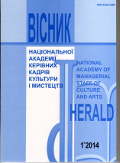ДО ПРОБЛЕМИ НОТАЦІЇ В ІТАЛІЇ ДОБИ ВІДРОДЖЕННЯ ХОРЕОГРАФІЧНИХ ТВОРІВ ДЛЯ ЇХ ЗБЕРЕЖЕННЯ ТА ВІДТВОРЕННЯ (перша половина XV – кінець XVI ст.)
DOI:
https://doi.org/10.32461/2226-3209.1.2014.137914Ключові слова:
балет, балетмейстер, мистецтво, нотація, сценічна хореографія, танцювальна лексика, хореографіяАнотація
Стаття присвячена виявленню специфіки нотації хореографічних творів епохи Відродження та є першою у добірці з чотирьох публікацій, присвячених проблемі нотації творів хореографії в Європі першої половини XV – першої половини ХХ ст. Період, що досліджується у першій статті, охоплює першу половину XV – кінець XVI ст. і обмежується Італією. Аналізуються праці Доменіко да П’яченцо "Про мистецтво танцю та вміння вести танець", Гульєльмо Ебрео да Пезаро "Про практику або мистецтво танцю", Антоніо Корназано "Книга про мистецтво танцю"та ін.
##submission.downloads##
Опубліковано
Номер
Розділ
Ліцензія
Автори, які публікуються у цьому журналі, погоджуються з наступними умовами:
1. Автори залишають за собою право на авторство своєї роботи та передають журналу право першої публікації цієї роботи на умовах ліцензії Creative Commons Attribution License International CC-BY, котра дозволяє іншим особам вільно розповсюджувати опубліковану роботу з обов'язковим посиланням на авторів оригінальної роботи та першу публікацію роботи у цьому журналі.
2. Автори мають право укладати самостійні додаткові угоди щодо неексклюзивного розповсюдження роботи у тому вигляді, в якому вона була опублікована цим журналом (наприклад, розміщувати роботу в електронному сховищі установи або публікувати у складі монографії), за умови збереження посилання на першу публікацію роботи у цьому журналі.
3.Політика журналу дозволяє і заохочує розміщення авторами в мережі Інтернет (наприклад, у сховищах установ або на особистих веб-сайтах) рукопису роботи, як до подання цього рукопису до редакції, так і під час його редакційного опрацювання, оскільки це сприяє виникненню продуктивної наукової дискусії та позитивно позначається на оперативності та динаміці цитування опублікованої роботи.

